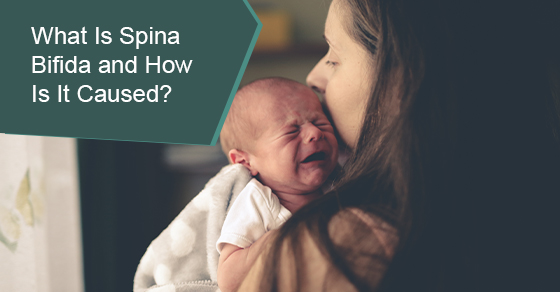Approximately 200 to 400 babies are born with spina bifida in Canada. That means that 2 to 4 babies are born each day with this life-altering condition.
What is spina bifida?
Spina bifida is a birth defect that occurs in the third and fourth weeks of pregnancy; it is one of the most common birth defects in Canada and it causes permanent disabilities. The disability occurs when a part of the fetal spinal cord fails to close properly; then, the child is born with a portion of the spine exposed on their back.
The type and symptoms of spina bifida can vary from individual to individual since it depends on the size and location of the openings in their spine. Symptoms can range from having no disabilities on one end, to having paralysis on the other. Then, there are those on the in-between spectrum who have movement and function limitations. The good news is that with proper treatment, those with spina bifida are able to live full lives.
3 Most Common Types of Spina Bifida
There are three forms of spina bifida:
Occulta
This is the least harmful type of spina bifida, as it is usually symptomless. Occulta spina bifida means that there is only a small gap in one or more vertebrae in the spine. The spinal cord and nerves are usually able to function normally and most children affected have no disabilities.
Meningocele
Meningocele spina bifida is the rarest form and can cause minor disabilities. This condition consists of a cyst or lump of membranes surrounding the spinal cord that pokes through an open part of the spine. This cyst can vary in size and can be removed by surgery, which allows for the normal development of the child.
Myelomeningocele
This type of spina bifida is the most common, as well as the most severe, as it causes moderate to severe disabilities. Up to 90 percent of children with this type of spina bifida will have hydrocephalus or fluid on the brain. Babies affected will be at a high risk of infection until the back is surgically closed. Even after surgery, there is risk of leg paralysis, and bladder and bowel control problems. This type of spina bifida occurs when there is an opening in the backbone and the sac of fluid containing part of the fetal spinal cord and nerves push through the opening, thus damaging both the tissues and the nerves.
How is spina bifida caused?
Spina bifida is known as a neural tube defect, meaning that it affects the structures that will eventually turn into the baby’s brain, spinal cord, and surrounding tissues. It can occur because of both genetic and environmental factors.
The rate of spina bifida cases has decreased recently, as more and more expecting mothers take part in preventative measures before and during the pregnancy, as well as undergo prenatal testing.
In terms of genetics, spina bifida can happen more often in families who are predisposed to birth defects, in particular trisomy 1B. Genetic screening can help you determine the risks and preventative measures.
Environmentally, spina bifida can be caused by various conditions during the pregnancy, such as:
- Taking certain medications;
- Diabetes, including Type 1, Type 2, and gestational diabetes;
- Obesity; and
- Folic acid deficiency.
Can spina bifida be prevented?
As much as 60 percent of all cases of spina bifida can be prevented if the mother had proper amounts of folic acid everyday prior to and during early pregnancy, which is before the neural structures close in the developing fetus. Women who have already had a baby with spina bifida or another neural tube disorder should do so in particular, as well as those with spina bifida, seizures, or diabetes disorders. It will be important to consult with their healthcare provider before another pregnancy to make sure that they are taking the right amount of folic acid.
There is no cure for spina bifida, and once a baby’s nerves are damaged, it cannot be regenerated. The most important prevention of spina bifida is detecting it before birth. When doctors detect spina bifida early, they can take immediate action to prevent infection and further damage to the fetal spine. In some clinics, they are able to conduct corrective surgery in-utero to prevent most, or all, problems associated with spina bifida.
The early detection of spina bifida is quite simple. We are able to see it on ultrasounds, so any properly trained ultrasound technician, radiologist, or obstetrician should be able to identify it and notify the mother’s doctor. Unfortunately, this is not always the case, and spina bifida can go undetected or it might not be mentioned until the birth of the baby. This grave mistake and negligence can lead to years of suffering and costly medical care.
Can you get compensation for your child’s spina bifida?
Doctors, nurses, and other medical professionals are obligated to provide their patients with proper care. Diagnosing spina bifida early is crucial for the baby’s future development and well-being. If a doctor or other health professional fails to diagnose the condition or they fail to properly communicate the condition to you, then the doctor might have committed medical malpractice.
If you think that your child’s spina bifida was overlooked by doctors prior to, during, or after birth, then you might have grounds for a medical negligence lawsuit that could give you financial compensation for yourself and your family.
Consult Expert Spina Bifida Lawyers in Canada Today
Our expert team of lawyers at Sommers Roth & Elmaleh have helped hundreds of Canadian patients win their medical malpractice lawsuits for decades. We have fought and won a substantial number of serious medical litigation cases, including spina bifida cases.
For more information about spina bifida, call Sommers Roth & Elmaleh at 1-844-777-7372 or contact us here.

